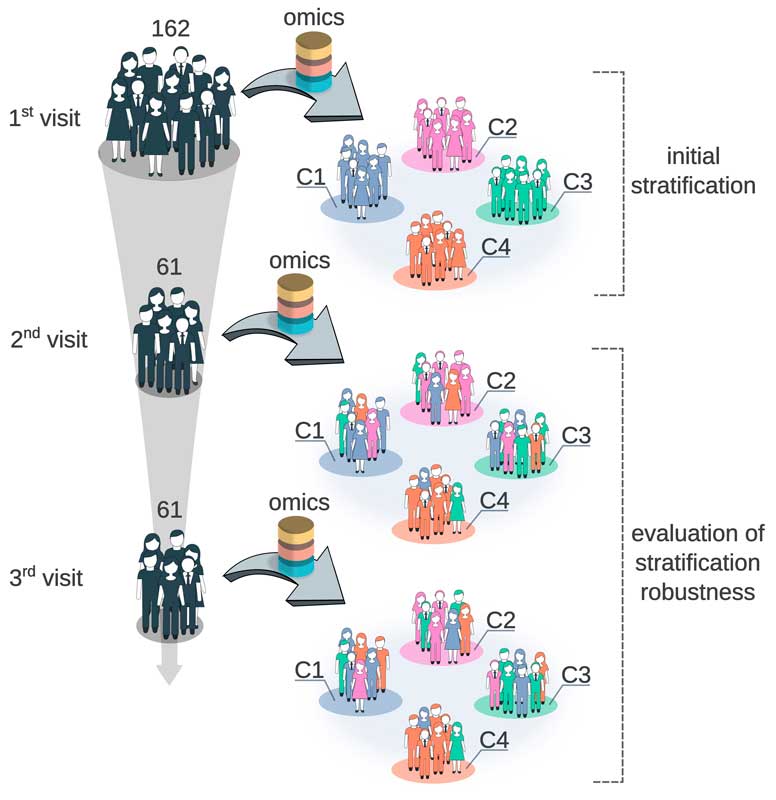
2025/06/19
CIC bioGUNE leads a study showing that multi-omic data can identify silent and stable risk profiles in healthy individuals
The study, conducted using local cohorts from the Basque Country, demonstrates how the bioinformatic integration of genetic, metabolomic, and lipoproteomic data allows for the early identification of disease risk in seemingly healthy individuals.
A multidisciplinary team from CIC bioGUNE research center, member of BRTA, with the participation of researchers from the CIBERehd network, has taken a step forward in the field of precision medicine with the publication of a study that highlights the value of integrating multiple layers of biological information - genomic, metabolomic, and lipoproteomic - to identify individuals with underlying molecular risk despite being apparently healthy and without relevant clinical manifestations. The study, recently published in npj Genomic Medicine, is based on the analysis of a cohort of 162 residents of the Basque Country and marks a milestone in designing early medical prevention strategies grounded in a new data paradigm.
The aim of the study was to identify biological subgroups among healthy individuals through the integrated analysis of omic data, enabling future population stratification and more precise personalization of preventive interventions. The research identified four distinct biomolecular profiles, one of which - referred to as cluster C4 - was particularly noteworthy for showing higher levels of triglycerides and lower HDL cholesterol, factors that may indicate a predisposition to dyslipoproteinemias and, by extension, cardiovascular diseases. This profile also remained molecularly stable over two years without any clinical manifestations, suggesting a “silent” risk that could be detectable through emerging bioinformatic techniques.
This pioneering approach demonstrates how research based on multi-omic data is not only capable of explaining pathological processes but also plays a key role in comprehensively understanding pre-disease states. This opens the door to public health strategies centered on prevention. The study also included a two-year longitudinal follow-up of a subset of participants, confirming the temporal stability of the molecular profiles - an essential factor for clinical application.
“This study shows that it is possible to detect molecular risk signals in a stable way, even before any disease symptoms appear. Particularly interesting is the fact that relevant aspects of these profiles are also reflected in parameters observable in routine clinical tests, which suggests potential for future translation into preventive medicine,” explains Dr. Urko M. Marigorta, principal investigator and Ikerbasque researcher of the Integrative Genomics group at CIC bioGUNE.
Beyond its scientific value, this research carries a strong territorial and social component, having been conducted using a local cohort. It contributes to the biomedical knowledge of the Basque population and reinforces the role of Euskadi as a benchmark in bioscience research. The approach highlights how the medicine of the future relies on complex data, integrated computational analyses, and longitudinal tracking of individuals to anticipate disease, rather than reacting only once it has manifested.
“It is essential to carry out this type of study with local populations, because precision medicine algorithms must be validated in each country’s specific context. Moreover, in Euskadi we have a responsibility to develop our own know-how in this field so we can effectively implement these new methodologies in our society,” adds Dr. Dimitrios Kioroglou, first author of the study and postdoctoral researcher of the Integrative Genomics group at CIC bioGUNE.
This study strengthens CIC bioGUNE’s commitment to research aimed at societal well-being and to the development of innovative solutions that address current and future healthcare challenges - within a paradigm where prevention and the personalization of medicine lie at the heart of scientific action.
Reference: Dimitrios Kioroglou, Rubén Gil-Redondo, Nieves Embade, Maider Bizkarguenaga, Ricardo Conde, Oscar Millet, José M. Mato & Urko M. Marigorta. Multi-omic integration sets the path for early prevention strategies on healthy individuals. NPJ Genom. Med. DOI: 10.1038/s41525-025-00491-7.
About CIC bioGUNE
The Centre for Cooperative Research in Biosciences (CIC bioGUNE), member of the Basque Research & Technology Alliance (BRTA), located in the Bizkaia Technology Park, is a biomedical research organization conducting cutting-edge research at the interface between structural, chemical, molecular and cell biology, with a particular focus on generating knowledge on the molecular bases of disease, for use in the development of new diagnostic methods and advanced therapies.
About Ikerbasque
Ikerbasque - Basque Foundation for Science - is the result of an initiative of the Department of Education of the Basque Government that aims to reinforce the commitment to scientific research by attracting, recovering and consolidating excellent researchers from all over the world. Currently, it is a consolidated organization that has over 350 researchers/s, who develop their work in all fields of knowledge.
About BRTA
BRTA is an alliance of 4 collaborative research centres (CIC bioGUNE, CIC nanoGUNE, CIC biomaGUNE y CIC energiGUNE) and 13 technology centres (Azterlan, Azti, Ceit, Cidetec, Gaiker, Ideko, Ikerlan, Leartiker, Lortek, Neiker, Tecnalia, Tekniker y Vicomtech) with the main objective of developing advanced technological solutions for the Basque corporate fabric.
With the support of the Basque Government, the SPRI Group and the Provincial Councils of the three territories, the alliance seeks to promote collaboration between the research centres, strengthen the conditions to generate and transfer knowledge to companies, contributing to their competitiveness and outspreading the Basque scientific-technological capacity abroad.
BRTA has a workforce of over 4,000 professionals, executes 22% of the Basque Country's R&D investment, registers an annual turnover of more than 300 million euros and generates 100 European and international patents per year.
See a large version of the first picture





